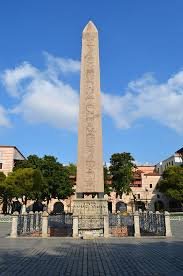History of Obelisk in Istanbul

History of Obelisk in Istanbul
hould we wonder today, “What is the story of the Obelisk in Sultanahmet, what do the writings on it mean?”
According to ancient Egyptian belief, the Sun was placed on a vertical stone on the first morning of the Earth. To symbolize this first moment, the Egyptians built an obelisk in Heliopolis (Sun City) south of the Nile River. The most beautiful obelisks, which became widespread later, were also made by the Egyptians. Obelisks were made of single pieces of stone with a four-cornered base, a body tapering upwards, and a pyramid-shaped top. Egyptians erected obelisks on both sides of the temple entrance. It was believed that these stones were used to attract the light of God and drive away evil spirits. Egyptian obelisks were made of stones carved from red granite. They would cover the top of the stone with silver or gold alloy.
The obelisk was first built by Egyptian pharaoh III. It was built by Thutmosis in the 15th century BC and was erected to the south of the seventh pylon of the Karnak temple. Roman Emperor II. In 357 AD, Constantius had the obelisk brought to the city of Alexandria over the Nile River in honor of the 20th anniversary of his accession to the throne. Later, in 390 AD, Emperor Theodosius I brought the obelisk to Istanbul by ship and had it erected in its current location in the Hippodrome.
The obelisk was made of red Aswan granite and its original height was 30 m. But since its lower part was destroyed either during transportation or when it was placed in its current location, its current height is 18.45 m (24.87 m with its base). Its weight is approximately 200 tons.
As for the hieroglyphic writings on the obelisk:
Northwest facade;
“18. 3rd in dynasty, owner of upper and lower Egypt. After offering his sacrifice to God Amon, Thutmosis, with the help of Horus, took control of all the seas and rivers and had this column built and erected on the thirtieth anniversary of his reign, for the holidays to come in the future.”
North facade:
“After offering his sacrifice in great helplessness to the god Amon, who is blessed with every manifestation of the secret and sacred name, begging for help from him, the friend of the south, the light of religion, the owner of two crowns, the mighty ruler, determined to expand the borders of his country to Mesopotamia.”
Southeastern front:
“The pharaoh, who carries the power, wealth, strong love and respect given by Horus, who spreads the golden colors of the sun when it rises to the world, and who has the crown of upper and lower Egypt and was chosen by the Sun himself, had this work built for his father Ra.”
Southern Front:
“The pharaoh, the ruler of Lower and Upper Egypt, who was granted the grace of God Horus and titled the son of the Sun, shed light on all horizons with power and justice. He went ahead of his army. “He wandered around the Mediterranean and defeated the whole world.”
The obelisk was erected for God “Amon”.
In other words, for “Amon Ra”.
Amon was one of the first gods of ancient Egypt.
He was the Sun God, even the king of the gods.
Egyptian inscriptions tell that “Amon Ra” lived with humans.
However, it is taller than humans.
Just like in the sentence “In those days, there were Nefilim (giants) on the earth. They were famous men from ancient times” in the creation chapter of the Torah.
It’s interesting.
The Torah, the first book of monotheistic religions, also mentions the children of God.
“The Nephilim took the beautiful daughters of men as women, and these women bore them children.”
Amon Ra also had three wives and three children from human daughters.
Ancient Egyptians ended every prayer by mentioning His name.
“AMON RA”
He believed that his sins would be erased.
*. *. *
It is possible that the Hebrews, who lived as slaves and captives in Egypt, were influenced by the name “AMON RA”, the symbol of the greatest power, and added the word “AMEN RAB” to their own language.
Because, in Hebrew AMEN; in the sense of approving, confirming, accepting, or bearing witness to the truth.
While this word passed unchanged into Latin, English, Spanish and other languages, it settled into Arabic as “AMEN”.
In short, a sacred oath that means “Oh God, accept my prayers”…
Amon Ra..
Amen Lord..
Amen O Lord..
These are the common and sacred language of believers.
All Categories
Recent Posts
Antalya, The Capiol City of Turkish Riviera
Turkey Touristic
Alanya, The Pearl of Turkish Riviera





